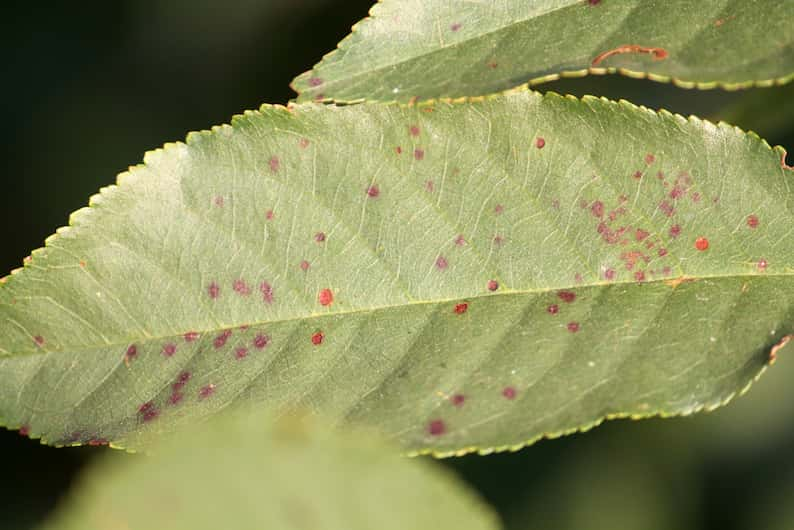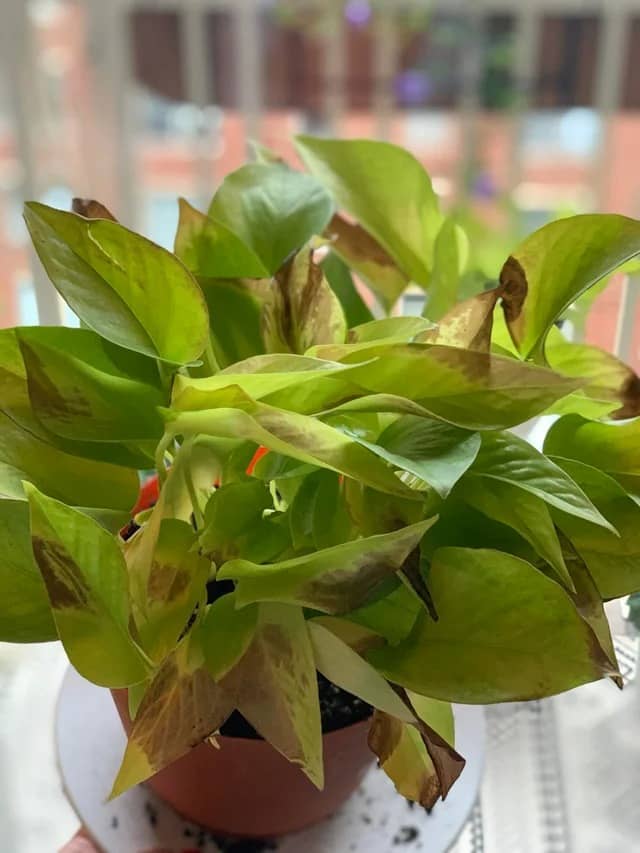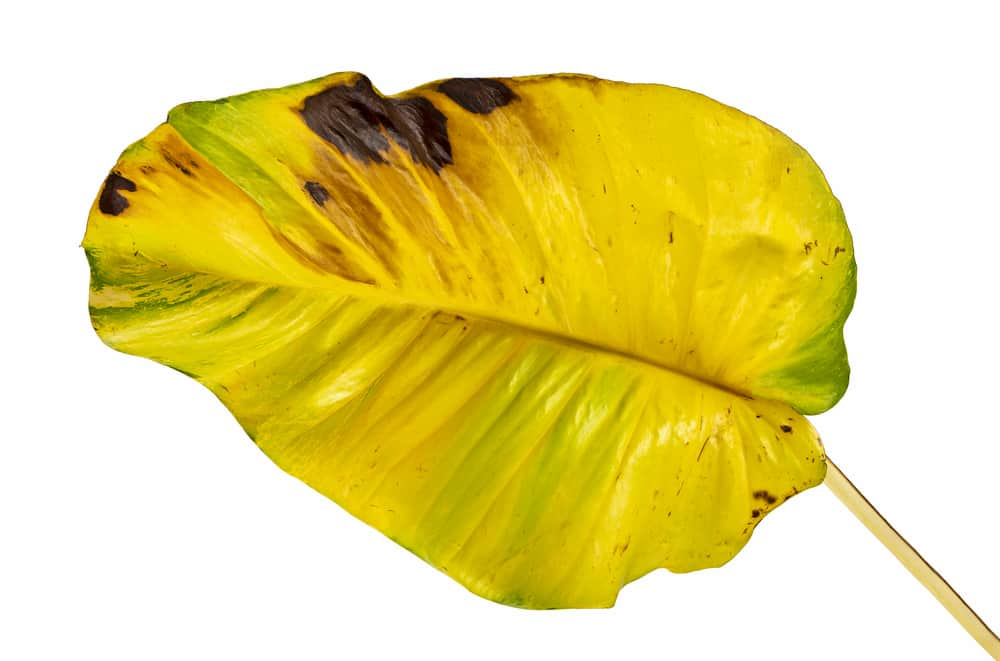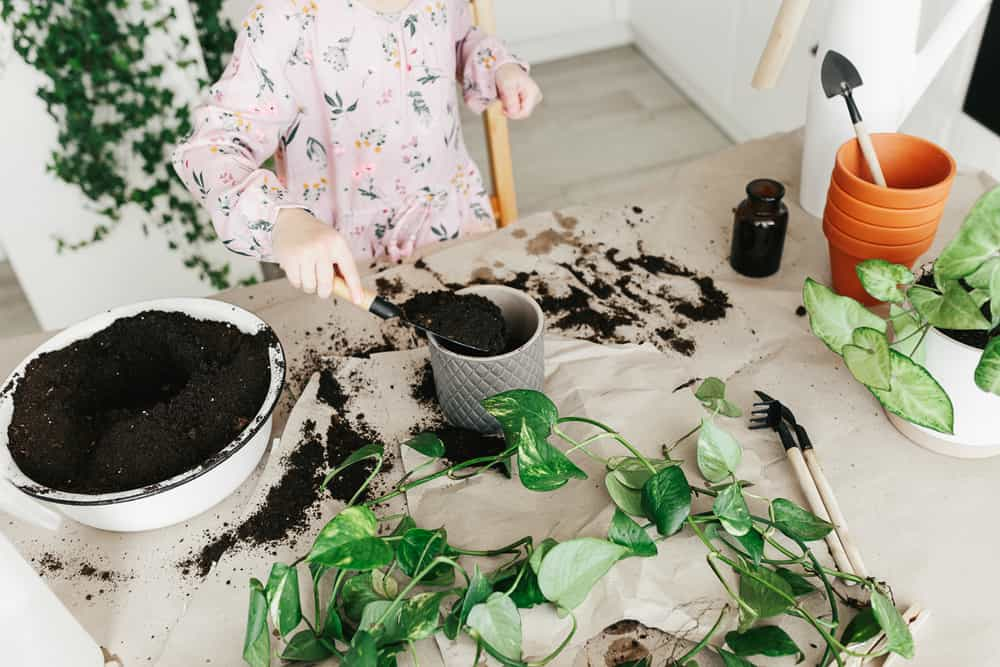If you have a pothos plant, then you may have noticed some brown spots on the leaves. This is a common problem for pothos plants, and there are several things that you can do to remedy it.
In this article, we will discuss what causes brown spots on pothos plants, and we will also provide some tips for how to fix the problem. Keep reading to learn more!

Table of Contents
Why is my pothos getting brown spots?
If you’ve noticed brown spots appearing on the leaves of your pothos plant, then you’re probably wondering what’s causing the problem. There are several possible reasons for brown spots on pothos plants, including:
1. Root rot
Root rot is a serious problem for pothos plants, and it can cause the leaves to develop brown spots. It is caused by a fungus, and it can kill the plant if it’s not treated.
Root rot in your pothos usually starts at the roots and then spreads to the rest of the plant, and can be identified by brown or black roots that are mushy to the touch.
2. Not enough water
Pothos plants don’t need too much water to get by, but if they aren’t watered for extremely long periods of time, it could lead to brown spots on the leaves.
This is because the leaves on an underwatered pothos will lose moisture, start to dry out, and turn brown.
3. Pests
There are many different types of pests that can attack pothos plants, and some of them will cause the leaves to develop brown spots.
For example, spider mites are tiny pests that feed on the sap of plants. They can cause the leaves to turn yellow or brown and eventually fall off the plant.

4. Leaf spot
Leaf spot is a type of fungal disease that can affect pothos plants, with bacterial leaf spot on pothos being particularly prevalent. It causes brown or black spots to form on the leaves, and it can eventually kill the plant if it’s not treated.
In order to identify leaf spot, you’ll need to look for circular or oval-shaped spots on the leaves that are brown, black, or yellow in color. You may also see spots that are raised or have a crusty texture
5. Bacterial infections
Some common bacterial infections that can affect pothos plants include Pseudomonas, Xanthomonas, and Erwinia. These infections cause the leaves to develop brown spots, and they can eventually kill the plant if they’re not treated.
It can be hard to identify bacterial infections, so it’s best to take your plant to a professional if you think this might be the problem.
6. Sunburn
If your pothos plant is getting too much direct sunlight, then the leaves may start to develop brown spots. This is because the leaves are getting sunburned.
Sunburnt pothos leaves will look brown and crispy, and they will eventually fall off the plant.

7. Fertilizer burn
If your plant has been given too much fertilizer, it can cause the leaves to change color. This is because the fertilizer will burn the leaves and cause them to turn brown.
Fertilizer burn is most likely to occur if you’ve used a high-nitrogen fertilizer on your pothos, so be sure to read the label carefully before applying it to your plant.
Best fertilizer for Pothos
Jack’s Classic 20-20-20 All Purpose Fertilizer
A great fertilizer with the perfect balance for your pothos. Simply dissolve in water and feed your plant to watch it thrive.
8. Rust
Rust may seem like a strange thing to find on a plant, but it’s actually a common occurrence that can affect pothos plants. Rust will cause the leaves to develop orangish brown spots, and it can eventually kill the plant if it’s not treated.
You’ll need to look for small, orange, or red bumps on the underside of the leaves in order to identify rust.
9. Aging leaves
As your pothos plant ages, the leaves will eventually become brown. This will start to happen at the tip of the leaves and then work its way down.
Once the leaves are entirely brown, they will eventually fall off the plant, if you haven’t pruned them off beforehand.

10. Nutrient deficiencies
It’s possible that your pothos leaves are turning brown because the plant doesn’t have enough nutrients. This can happen if you’re not fertilizing the plant regularly, or if the soil isn’t rich in nutrients.
The plant may also appear wilted, leggy, or produce small leaves if this is the case.
You may also be interested in: 8 Best Ways to Deal With Leggy, Long Pothos Vines (So It Thrives)
11. The plant is dormant
Late fall, winter, and early spring months are typically when pothos plants go dormant. During this time, a handful of the leaves may turn brown and eventually fall off the plant.
This is normal and nothing to worry about, as the plant will start to grow new leaves once spring arrives.
How to treat brown spots on pothos leaves
Now that you know the reasons why you might see brown spots on pothos leaves, you’re probably wondering how to treat them. Here are a few tips:
1. Isolate the plant
If you suspect that your plant has a disease or pest, it’s important to isolate it from other plants, as this will help to prevent the problem from spreading. Spores and bacterial infections can be easily spread from one plant to another, so it’s best to err on the side of caution.
Place the affected plant in a well-ventilated room away from other plants, and make sure to wash your hands after handling it.

2. Treat the plant with neem oil
Neem oil is a natural insecticide that can be used to treat brown spots on pothos leaves – I prefer PetraTools Pure Neem Oil (check the current price here).
Mix a solution of neem oil and water, and then use it to treat the affected areas. Be sure to follow the instructions on the bottle carefully, as too much neem oil can damage the plant.
3. Water your pothos appropriately
One of the most common reasons for brown spots on pothos leaves is underwatering. Make sure to water your pothos only when the soil is dry to the touch, and be sure to empty any excess water from the saucer after watering.
Allow the plant to dry out completely before watering it again, which will take 1 to 2 weeks.
4. Prune your pothos
Pruning the brown leaves off of your pothos plant can be a good solution if the browning has affected less than one-third of the plant. You can prune your pothos by cutting the leaves off at the stem, and being sure to use a sharp and clean knife or set of shears.
Brown leaves can also be removed by hand, but take care not to damage the plant in the process.

5. Cut back on fertilizer
If you suspect that your plant is being “burned” by too much fertilizer, it’s best to cut back on the amount you’re using. Water the plant thoroughly before applying any fertilizer, and be sure to use a diluted solution, cutting the frequency in half or even lower.
Once the problem has been resolved, you can slowly start to increase the amount of fertilizer you use.
6. Clean the roots
If root rot is the problem, you’ll need to cut away the affected roots and replant the pothos in fresh soil. Be sure to sterilize your cutting tools before and after use, and dispose of any infected plant material properly.
Once the plant has been replanted, water it well and keep an eye on it for further problems.
7. Repot your plant
If your plant is rootbound or experienced root rot, pothos will need to be repotted in a larger container. Be sure to use fresh potting soil, and water the plant well after repotting.
Best soil for Pothos
Miracle-Gro Tropical Potting Mix
Light and well-draining (perfect for avoiding root rot) while being packed with just the right nutrients – that will feed your plant for up to six months. The best soil for keeping your pothos healthy and strong.
Make sure to also use a container that has drainage holes to avoid problems with root rot in the future.

8. Move your plant away from direct light
As mentioned above, direct bright light can be bad for your pothos plant and sunburn it. The solution for this is easy – simply move your plant a bit further away from the light source to adequately meet your pothos’ light needs.
Another solution is to provide the plant with filtered light by using a sheer curtain or placing it behind a piece of furniture.
9. Let your plant rest during winter
Many plants go dormant during the winter months, and your pothos is no exception. During this time, it’s best to let your plant rest and cut back on watering.
Allow the soil to dry out completely between waterings, and don’t fertilize the plant during this time.
Should I remove pothos leaves with brown spots?
Depending on the severity of the problem, you may or may not need to remove the leaves with brown spots. If the browning is minor, removing a few leaves may be sufficient. However, if the browning is widespread or affects the plant’s health, the plant may be damaged beyond repair.
In general, you should only remove up to one-third of the leaves, as removing too many leaves can stress the plant and cause further problems. If you do need to remove a large number of leaves, it’s best to do so gradually over a period of time to avoid shocking the plant.

If your plant is relatively healthy, cutting off the brown leaves should not cause any long-term damage. However, if the plant is already stressed or unhealthy, removing the leaves may cause further problems.
If you’re not sure whether or not to remove the leaves, it’s best to err on the side of caution and leave them be. Try to focus on other solutions, such as increasing the frequency of watering or moving the plant to a shadier location.
Why are my pothos leaves turning brown in water?
If the leaves of your pothos plant are turning brown in water, it’s likely due to leaves being submerged for extended periods of time. While pothos can tolerate having its leaves submerged, it’s not ideal and can cause problems such as leaf browning, rotting, or death.
To avoid this problem, when growing a pothos cutting in water, be sure to remove any leaves that are at or below the water level.
The quality of the water itself may also affect the health of your pothos plant. If the water is high in chlorine, fluoride, or other contaminants, it can cause leaf browning or death. Be sure to use filtered or distilled water for your plant to avoid this problem.

You can easily remove chlorine from your water for your plants by boiling water for at least five minutes and then allowing it to cool before using it. This will also help to kill off any pathogens that may be present in the water.
You may also want to transfer the plant into a pot with soil to avoid further problems.
Why is my pothos growing brown tips?
A pothos with brown tips is usually due to your plant being underwatered or exposed to too much direct light. It may also be a sign of too much fertilizer or a disease issue. Try to increase the frequency of watering and move the plant to a shadier location.
If the problem persists, look into the other potential causes.
How do you fix brown tips on pothos?
Use a non-burning fertilizer such as fish emulsion to help correct the problem naturally. A heavy watering will help to flush out the salts that have built up in the soil and may also help lessen the brown tips. If you suspect that your plant has a disease, isolate it and treat it accordingly.
Should I cut brown tips off my pothos?
It’s generally best to avoid cutting brown tips off plants, as this can damage the plant and cause further stress. If the browning is minor, it doesn’t drain much energy from the plants and doesn’t need to be disturbed. But if the browning continues along the leaf, cut the entire leaf off to redirect energy to healthier leaves.
Can a brown leaf on pothos turn green again?
Unfortunately, it is unlikely that a brown leaf on a pothos will turn green again. This is because the plant has stopped producing chlorophyll in the leaf and it is redirecting its energy to newer growth. This means that the plant will continue to brown, dry up, and eventually fall off.
If there is only a small amount of browning on the leaf, such as the tip or one small sunburn spot, the leaf will likely have a lot of life left in it. However, this brown “scar” will always be present.
The best way to minimize brown spots on pothos leaves is by catching it before the color fully changes. Look for wilted, small, or yellow colors on your leaf to indicate that it is not getting enough water. Try to increase the frequency of watering or moving the plant to a shadier location. If the problem persists, look into other potential causes such as too much fertilizer or a disease issue.
How do you revive a pothos plant?
If your pothos plant is looking wilted, yellow, or overall unhealthy, it may need to be revived. Start by giving the plant a good watering and moving it to a shadier location. Do everything you can to replicate the environment that the pothos is used to, meaning tropical conditions.
This means paying attention to the temperature, humidity, and airflow of the room that your pothos plant is in. By adjusting these factors, you can help your pothos plant to recover.
If your plant is suffering from a bacterial or fungal infection, you will need to treat it accordingly. Isolating the plant and using a fungicide or bactericide can help to clear up the infection and revive your pothos plant.

Removing infected areas of the plant is crucial to ensure that the infection doesn’t spread. Cut off any leaves that are discolored or have brown spots, as well as stems and roots. Give your plant new soil that is preferably sterilized.
Be very gentle with your pothos plant during this process. It is already sick and stressed, so the shock of being moved or having its leaves cut off can be too much for the plant to handle. Try to do everything gradually and give your pothos plant the best chance possible to recover.
Pothos plants are generally very resilient, so with the right care, your plant should be back to health in no time.
Why is my variegated pothos turning brown?
Variegations on leaves are usually caused by a lack of chlorophyll. Chlorophyll is essential for plants to perform photosynthesis and produce their own food. When there is a lack of chlorophyll, the plant cannot produce enough food to sustain itself and will begin to turn brown if left in excessive sunlight.
Variegated pothos plants are very sensitive to sunburn, so it is important to protect them from direct sunlight. If your plant is placed in too much sun, the leaves will begin to turn brown and eventually crisp and die.
On the other hand, if your variegated plant doesn’t receive enough light, the leaves may revert back to all green. These plants require a delicate balance and the jade pothos and golden pothos are good varieties for beginner gardeners.
What pests may cause brown spots on my pothos plant?
There are a few pests that may cause brown spots on your pothos plant:
Scale insects
One of the most common is scale insects. Scale insects suck the sap out of plants, which can change the leaves’ colors as well as dry out the plant overall. You can spot scale insects by their small, hard shells that are often brown or black in color.
Mealybugs
Mealybugs are another type of pest that can attack pothos plants and feed on plant sap. They excrete a sticky substance called honeydew, which can attract other pests like ants and wasps. Mealybugs are typically white with a waxy coating and tend to congregate in groups on the stems and leaves of plants.
Aphids
Pothos with brown spots may be a result of aphids. Aphids are small, green insects that also suck the sap out of plants. Aphids can cause the leaves of your pothos plant to turn yellow or brown and may also cause the plant to become stunted.
Spider mites
Spider mites are tiny spider-like creatures that feed on plant sap. They are very difficult to see with the naked eye but can be identified by their webbing. Spider mites can cause brown spots on leaves as well as overall yellowing and wilt the plant.


